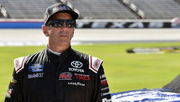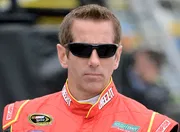

In 2022, NASCAR unveiled its most meticulously engineered race car to date, a marvel that transformed the racing landscape. This next-gen car, with its cutting-edge technology and advanced aerodynamics, not only spiced up the competition at numerous tracks but also seems to have played a pivotal role in boosting both attendance and television viewership. It’s a clear leap forward from its predecessors, a testament to NASCAR’s relentless pursuit of innovation.
Watch What’s Trending Now!
The next-gen cars were engineered to such perfection that their speed and features were nearly indistinguishable across teams. This uniformity became a double-edged sword—while it leveled the playing field for many, a few teams found it challenging. Despite this, the overall impact of these cars has been largely on the positive side.
However, there are still kinks to iron out, particularly in optimizing these next-gen cars for short tracks. NASCAR icon Dale Earnhardt Jr has recently shed light on the cost of one of these high-tech machines. As the series continues to evolve, it remains a thrilling journey for fans and teams alike, watching these incredible machines and their drivers push the limits on the track.
ADVERTISEMENT
The high cost of innovation in NASCAR’s next-gen cars
NASCAR’s Next-Gen car, a striking blend of the Chevrolet Camaro ZL1, Ford Mustang, and Toyota TRD Camry, ushers in an era of sleek, coupe-like aesthetics. Each model boasts a shorter greenhouse, a compact deck lid, and an expanded track width, complemented by striking 18″ forged aluminum wheels and broader tires. A notable departure from tradition is the switch to a single lug-nut design, moving away from the classic five-lug-nut configuration.
The design revolution extends to the car’s body, now fully symmetrical, cutting down aerodynamic forces and shifting the focus back to car setup and driver prowess. Ditching sheet metal, the Next Gen car’s body is crafted from a composite material, enhancing durability and maintaining performance even after wall or car contact.
ADVERTISEMENT
The advent of Next Gen cars marks a significant shift from the past, when teams had the freedom to tailor their cars, from horsepower to brake rotors. This liberty often gave well-funded teams an upper hand, while smaller teams struggled with limited resources and manpower.
In a candid discussion with Kenny Wallace on his show, Dale Earnhardt Jr. expressed nostalgia for the days of creative modifications, observing, “As we go through the next-gen full of years, maybe those high buck teams distance themselves from everybody else, just like the old car. […] it costs a lot of money these days too. They are out there racing Lamborghinis, you know. So, $350, 000 race car,” a sentiment echoed by Kenny Wallace.
ADVERTISEMENT
ADVERTISEMENT
However, this isn’t the first time Dale Jr or Kenny Wallace have voiced concerns about the Next Gen cars.
Watch This Story: Dale Earnhardt Jr’s Surprising Revelation
In a recent podcast, Dale Earnhardt Jr subtly critiqued NASCAR’s approach to next-gen vehicles, highlighting the ongoing debate surrounding this cutting-edge yet costly innovation in the racing world.
ADVERTISEMENT
Top Stories
Footage Surfaces of Florida Police Arresting NASCAR Veteran Over Disturbing Public Misbehavior

Horrific Aerial Footage of Greg Biffle’s Fatal Crash Emerges Leaving NASCAR Community in Tears

Another Almost Fatal Disaster Surfaces From Statesville Airport Amidst Ongoing Greg Biffle’s Crash Investigation

Donald Trump Issues Moving Message of Condolence for NASCAR’s Greg Biffle & Family During North Carolina Address

NTSB Appeals for Greg Biffle’s Wife’s Alleged In-Flight Text Messages as Crash Investigation Heats Up

Dale Earnhardt Jr. reflects on the impact of next-gen cars in NASCAR
In an engaging episode of his podcast, Dale Earnhardt Jr., alongside co-host Mike Davis, delved into the intriguing possibility of Shane Van Gisbergen transitioning from Supercars to NASCAR. Junior shared his insights, suggesting that SVG might find it relatively easy to adapt to NASCAR’s next-gen car, possibly even more seamlessly than Marcos Ambrose did when he shifted from the Australian V8 Supercar Series championship to NASCAR in 2006.
Junior pointed out an interesting parallel: “The V8 Supercar was the closest thing to NASCAR stock cars around the globe, and that got even closer when the next-gen car was built. NASCAR and Steve O’Donnell will tell you they built the NASCAR next-gen based off of the V8 Supercar. So for Shane or anyone to get in that car and feel comfortable makes perfect sense, and I think his adaptation to ovals will be even easier due to that than it was for Marcos,” he explained.
ADVERTISEMENT
This leads to an intriguing thought: if NASCAR’s next-gen car draws heavily from another motorsport’s design, it opens doors for racers from different disciplines to shine in NASCAR. Also, the move, while diluting the uniqueness once found in NASCAR’s garage creativity, also seems to level the playing field, especially for smaller teams.
But what if the decision had struck a balance between preserving that creativity and benefiting all teams? Could this have led to a different landscape in the sport today?
ADVERTISEMENT
ADVERTISEMENT
ADVERTISEMENT
ADVERTISEMENT

